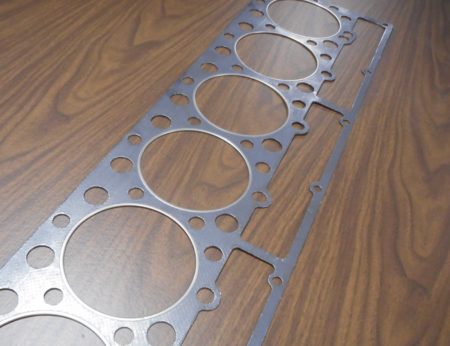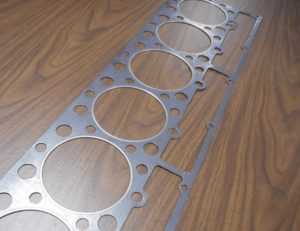 Sometimes bad things can happen to good engines. This can be the case with a head gasket failure. Depending on the design requirements and the suitability of your gasket material for the application, the useful service life will vary. However, any application that is in use long enough may require a replacement of the head gasket.
Sometimes bad things can happen to good engines. This can be the case with a head gasket failure. Depending on the design requirements and the suitability of your gasket material for the application, the useful service life will vary. However, any application that is in use long enough may require a replacement of the head gasket.
Head gaskets are one of the more difficult repairs on an engine. They require substantial removal of parts, careful cleaning and preparation of surfaces, and methodical replacement and reassembly of the engine components. Nobody really WANTS to replace a head gasket, but sometimes, it’s just necessary.
How do you know when this is needed? Here are a few warning signs:
It’s time to replace your head gasket when there is…
1. Loss of compression
Failure of the combustion seal results in a loss of compression in the engine and loss of power. This is normally obvious when it occurs and requires a replacement of the head gasket right away.
2. Coolant in the oil (internal loss of fluid)
If the body of the gasket loses load and leaks coolant into the oil ports, bad things happen. The oil will be compromised in its lubricity, resulting in possible damage to the internal engine parts. It may also result in excessive heat and other failures. This requires replacement of the head gasket immediately.
3. Leakage down the block (exterior loss of fluid)
The body can also fail to seal the fluid ports resulting in external leakage of the fluid (either oil or coolant) down the side of the block. This can be a more gradual failure of the head gasket and often not noticed until much later.
Replacing a Head Gasket
If you have arrived at the decision that a head gasket needs to be replaced, you need to be aware of a few things.
1. Know that you may not be able to replace it with a similar gasket material without significant repair cost also put into the flanges.
Why? If the original gasket was a MLS (multi-layer steel) construction, this will require extremely smooth surface finish preparation (which equals repair costs). There are other gasket material technologies out there that will save you from this cost.
2. There are various types of replacement head gaskets available.
Graphite products are an excellent choice and can be made to the required thickness and density to meet your needs.
3. It is a complicated repair and replace operation, but not impossible.
Once completed, the engine will have a new lease on life for many more happy miles.
If you have any questions about what you’re seeing with your gasket material, or are looking for suggestions on the types of gasket materials that will work best when a head gasket is being replaced, talk to your trusted gasket material supplier. They will be able to get you going in the right direction.
Is there anything you would add to the warning signs list? If you are interested in subscribing to Sealed-In’s blog posts, email sales@mtigasket.com.

Sometimes bad things can happen to good engines. This can be the case with a head gasket failure. Depending on the design requirements and the suitability of your gasket material for the application, the useful service life will vary. However, any application that is in use long enough may require a replacement of the head gasket.
Head gaskets are one of the more difficult repairs on an engine. They require substantial removal of parts, careful cleaning and preparation of surfaces, and methodical replacement and reassembly of the engine components. Nobody really WANTS to replace a head gasket, but sometimes, it’s just necessary.
How do you know when this is needed? Here are a few warning signs:
It’s time to replace your head gasket when there is…
1. Loss of compression
Failure of the combustion seal results in a loss of compression in the engine and loss of power. This is normally obvious when it occurs and requires a replacement of the head gasket right away.
2. Coolant in the oil (internal loss of fluid)
If the body of the gasket loses load and leaks coolant into the oil ports, bad things happen. The oil will be compromised in its lubricity, resulting in possible damage to the internal engine parts. It may also result in excessive heat and other failures. This requires replacement of the head gasket immediately.
3. Leakage down the block (exterior loss of fluid)
The body can also fail to seal the fluid ports resulting in external leakage of the fluid (either oil or coolant) down the side of the block. This can be a more gradual failure of the head gasket and often not noticed until much later.
Replacing a Head Gasket
If you have arrived at the decision that a head gasket needs to be replaced, you need to be aware of a few things.
1. Know that you may not be able to replace it with a similar gasket material without significant repair cost also put into the flanges.
Why? If the original gasket was a MLS (multi-layer steel) construction, this will require extremely smooth surface finish preparation (which equals repair costs). There are other gasket material technologies out there that will save you from this cost.
2. There are various types of replacement head gaskets available.
Graphite products are an excellent choice and can be made to the required thickness and density to meet your needs.
3. It is a complicated repair and replace operation, but not impossible.
Once completed, the engine will have a new lease on life for many more happy miles.
If you have any questions about what you’re seeing with your gasket material, or are looking for suggestions on the types of gasket materials that will work best when a head gasket is being replaced, talk to your trusted gasket material supplier. They will be able to get you going in the right direction.
Is there anything you would add to the warning signs list? If you are interested in subscribing to Sealed-In’s blog posts, email sales@mtigasket.com.

Sometimes bad things can happen to good engines. This can be the case with a head gasket failure. Depending on the design requirements and the suitability of your gasket material for the application, the useful service life will vary. However, any application that is in use long enough may require a replacement of the head gasket.
Head gaskets are one of the more difficult repairs on an engine. They require substantial removal of parts, careful cleaning and preparation of surfaces, and methodical replacement and reassembly of the engine components. Nobody really WANTS to replace a head gasket, but sometimes, it’s just necessary.
How do you know when this is needed? Here are a few warning signs:
It’s time to replace your head gasket when there is…
1. Loss of compression
Failure of the combustion seal results in a loss of compression in the engine and loss of power. This is normally obvious when it occurs and requires a replacement of the head gasket right away.
2. Coolant in the oil (internal loss of fluid)
If the body of the gasket loses load and leaks coolant into the oil ports, bad things happen. The oil will be compromised in its lubricity, resulting in possible damage to the internal engine parts. It may also result in excessive heat and other failures. This requires replacement of the head gasket immediately.
3. Leakage down the block (exterior loss of fluid)
The body can also fail to seal the fluid ports resulting in external leakage of the fluid (either oil or coolant) down the side of the block. This can be a more gradual failure of the head gasket and often not noticed until much later.
Replacing a Head Gasket
If you have arrived at the decision that a head gasket needs to be replaced, you need to be aware of a few things.
1. Know that you may not be able to replace it with a similar gasket material without significant repair cost also put into the flanges.
Why? If the original gasket was a MLS (multi-layer steel) construction, this will require extremely smooth surface finish preparation (which equals repair costs). There are other gasket material technologies out there that will save you from this cost.
2. There are various types of replacement head gaskets available.
Graphite products are an excellent choice and can be made to the required thickness and density to meet your needs.
3. It is a complicated repair and replace operation, but not impossible.
Once completed, the engine will have a new lease on life for many more happy miles.
If you have any questions about what you’re seeing with your gasket material, or are looking for suggestions on the types of gasket materials that will work best when a head gasket is being replaced, talk to your trusted gasket material supplier. They will be able to get you going in the right direction.
Is there anything you would add to the warning signs list? If you are interested in subscribing to Sealed-In’s blog posts, email sales@mtigasket.com.
